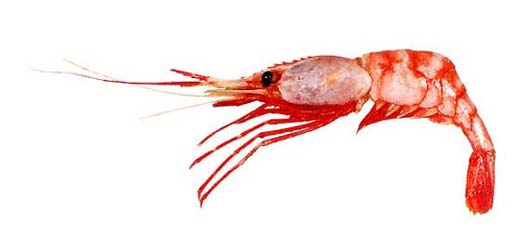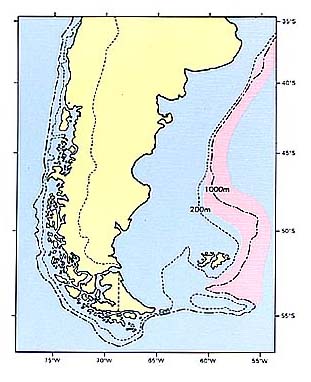タラバエビ科
- HOME
- デジタル図鑑
- パタゴニア海域の重要水族
- 節足動物門 甲殻綱 十脚目
- タラバエビ科
タラバエビ科(Pandalidae)

135 アメリカヒゴロモエビ(Amerika-higoromoebi)
Pandalopsis ampla Bate, 1888
特 徴:
深海産の大型種で,体長20 cmに達する。頭胸甲は円筒系に近く,無毛で滑らか。側面には特別の溝,稜,とげなどはない。触角上棘は大きく,前方を向くが,鰓前棘はごく小さく,斜め下方を向く。額角は基部1/3ほどのところで強く湾曲し,そこから前方が斜め上方を向く。額角は頭胸甲長の約1.5倍に達し,上縁の基部1/3から頭胸甲上の前半部にかけて7〜13本の可動棘(眼窩底部より後方には3〜5本),上縁先端に1,2歯,下縁には全長にわたって鋭い12〜16歯がある。第3腹節の背正中線後半部は鈍い稜をなす。第4腹節以後は急に細くなり,側甲の後端部には鋭いとげがある。尾節は細長く,背面側縁に沿って5対の可動棘があるが,最後のものは後縁側端に位置する。尾節の後縁には2対のとげがあるが,側方のものが明らかに長い。付属肢は長くてしっかりしている。第1胸脚の座節の下縁は葉状に広がっているが,これは属の特徴である。第2胸脚は小さなはさみをもち,腕節は20以上に分節する。第3〜5胸脚の長節後縁部上下にはそれぞれ7,8本の可動棘が並び,また,腕節後縁にも4,5本の可動棘がある。指節はごく短く,後縁に約10本のとげが並んでいるが,先端に近いものほど長い。卵は大きく,孵化直前卵は5×4 mmほどである。
分 布:
南西大西洋アルゼンチン沖のほか,北アメリカ太平洋岸のワシントン州からメキシコアカプルコ沖にかけても分布している。水深555〜1,770 m。
備 考:
北東太平洋産の個体群がアルゼンチン沖の個体群と真に同種であるかどうかは明らかでない。本種は一般的な外形も色彩も日本産のヒゴロモエビによく似ているが,額角上縁の可動棘数が少ないかわり,下縁の歯数が多い。
文 献:
Bate (1888); Rathbun (1904); Boschi (1973).
(武田正倫)
Material examined:
FSFL EM122 (1 ovig.♀-47°04′S, 60°06′W, 695 m deep; Apr. 23, 1978); EL963 (1 ovig.♀,3 exs-47°59′S, 60°W, 564 m deep; May 25, 1978);EM334 (1 ovig.♀,2 exs-37°56′S, 54°41′W, 795 m deep; June 21, 1978); EM398 (1 ex-52°32′S, 60°10′W, 1,033 m deep; Aug. 5, 1978). Total length from tip of rostrum to posterior margin of telson, about 15.5 cm in a specimen (EM398).
Description:
A deep-sea large species. Carapace smooth without any groove, ridge and spine; antennal spine porminent and directed forward, while a branchiostegal spine is small and curved weakly downward. Rostrum long, about 1.5 times as long as carapace, curving obliquely upward at proximal third; upper margin with 7-13 movable spines from proximal third of rostrum to anterior half of carapace (3-5 on carapace); distal part of upper margin with 1 or 2 spinules, and lower margin with 12-16 sharp spines on its whole length. Distal half of dorsal margin of third abdominal segment bluntly ridged; fourth to sixth abdominal segments narrow, each with a sharp spine at tip of pleura. Telson slender and armed with 5 pairs of movable spines; 2 pairs of spines, the shorter inner and longer outer ones, present on posterior margin. Chelate second pereiopod with carpus subdivided into 20-24 segments; each merus of last 3 pereiopods with 2 rows of several movable spines on both posterior margins, and carpus also with some; dactylus very short and armed with about 10 spinules which become longer distally. Eggs large, with 5×4 mm in eyed stage.
Distribution:
Southwest Atlantic, and Northeast Pacific from off Washington to Mexico; 555-1,770 m deep.
Remarks:
The identity of the Northeast Pacific population with the Southwest Atlantic one is not always certain. On the other hand, the general shape and color is really close to P. coccinata Urita from Japanese waters, but the numbers of the rostral teeth are different in both species.
(Masatsune TAKEDA)

Distribution of Pandalopsis ampla in Patagonia.
- 1